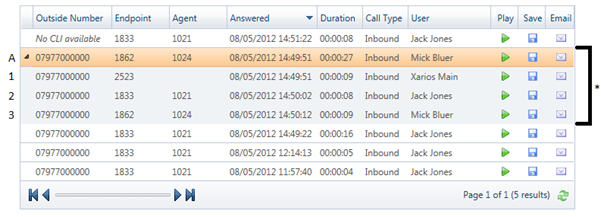

The system integrates with the PBX they are connected to by having a connection to the device that they are recording. Depending on if the recorder is a trunk/line side or extension side then additional information will be provided about the call in addition to the actual audio file itself.
This integration requires no configuration/licensing etc. on the PBX as all the information about the call is provided via the recording device connection, i.e. from the TAP on the device.
For trunk side recording as the extension information cannot be obtained via the recording device connection then an SMDR link to the PBX can be used. The SMDR connection provides a record of a call once it has cleared that can include: the outside number, extension, answer time and duration. The recorder can then use the outside number, answer time and duration to try and find a matching call recording to tag against the extension.
This integration requires additional configuration and/or licensing on the PBX and the reliability of being able to match the call recording and the extension can be variable depending on the environment and circumstances.
Additional information about the call can be obtained by connecting to the CTI connection on the PBX (if one is available and supported). This provides a more reliable way to retrieve the extension and can provide more information, i.e. agent, group, DNIS, account code, that can be used to tag against the call.
Most call recording and reporting applications only record this basic information and for trunk side often only take into account the last extension that handled the call. The full journey that the call has actually taken becomes lost and cradle to grave reporting becomes difficult if not impossible.
For example with trunk side recording if calls are routinely transferred through the PBX between extensions, trying to find a specific call is only possible using the information about the last extension. Additional information about other groups, agents, extension etc. that have been involved with the call becomes lost along with the durations, for example when calls are transferred, diverted, forwarded, recalled or overflowed. With extension side as there may be multiple recordings for a single call, one for each extension that handled the call, then it becomes difficult to see the entire call from cradle to grave as not all of the call would have been recorded (i.e. when the call is on hold, at an auto attendant etc).
Having call segmentation helps overcome some of these issues by providing the following features:
1. More detailed PBX information relating to the call recording.
2. Combining individual call recordings into a single logical call that can be accessed as a whole.
The amount of information and features that can be provided with using segmentation can vary depending on the PBX connected to and the line types that are been recorded.
The example below shows 5 separate calls with the last device that handled the call before it was cleared shown in the Endpoint and Agent columns. Without segmentation then only the last device that handled the call would be tagged against the call record.

With segmentation enabled each row on the grid shows either a single segment of the call or an aggregate call if there is more than one segment. The aggregate calls are shown with a  at the start of the row, clicking on this expands the grid to show all the separate segments.
at the start of the row, clicking on this expands the grid to show all the separate segments.

The * on the right shows a single logical call that has been segmented. The row marked A is the aggregate entry that is displayed when the row is collapsed and summarizes all segments, showing the details of the last device that handled the call. Rows 1, 2 and 3 show the individual segment details of the call.
Full segmentation is used with both trunk side and extension side and may produce multiple audio files for a single call. Each time a call is transferred a new call segment and audio file will be generated. All of the individual recordings and the call information will then be grouped into the same logical call record. The benefits of full segmentation are:

